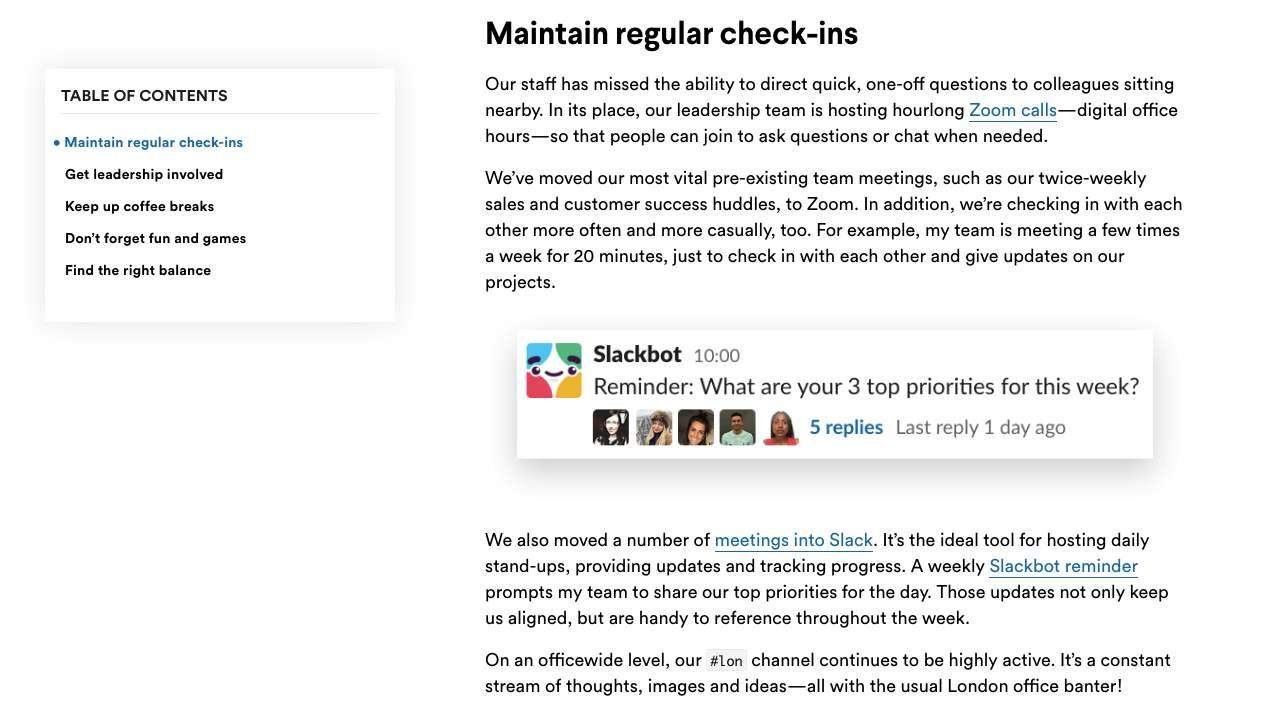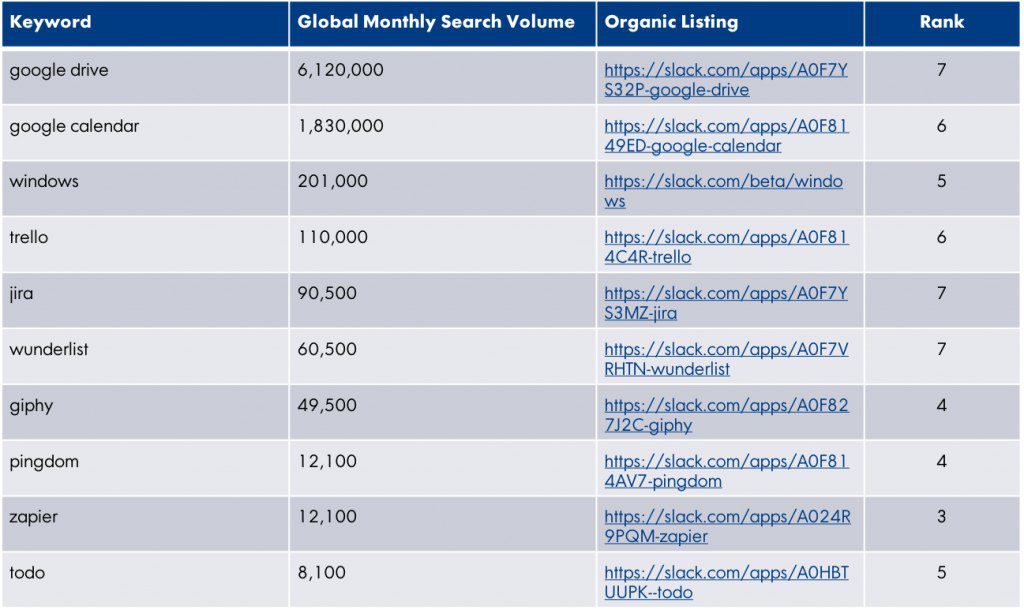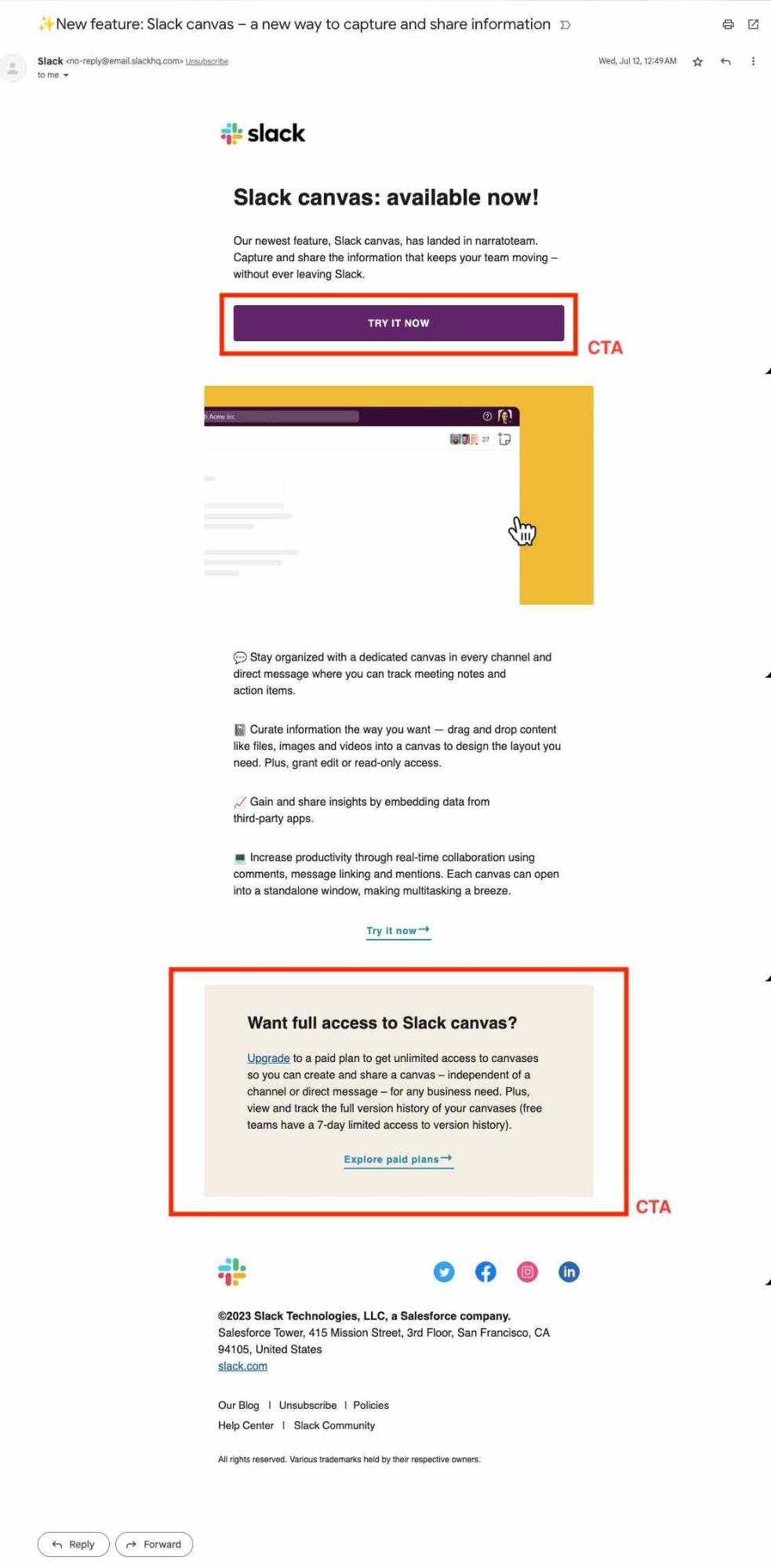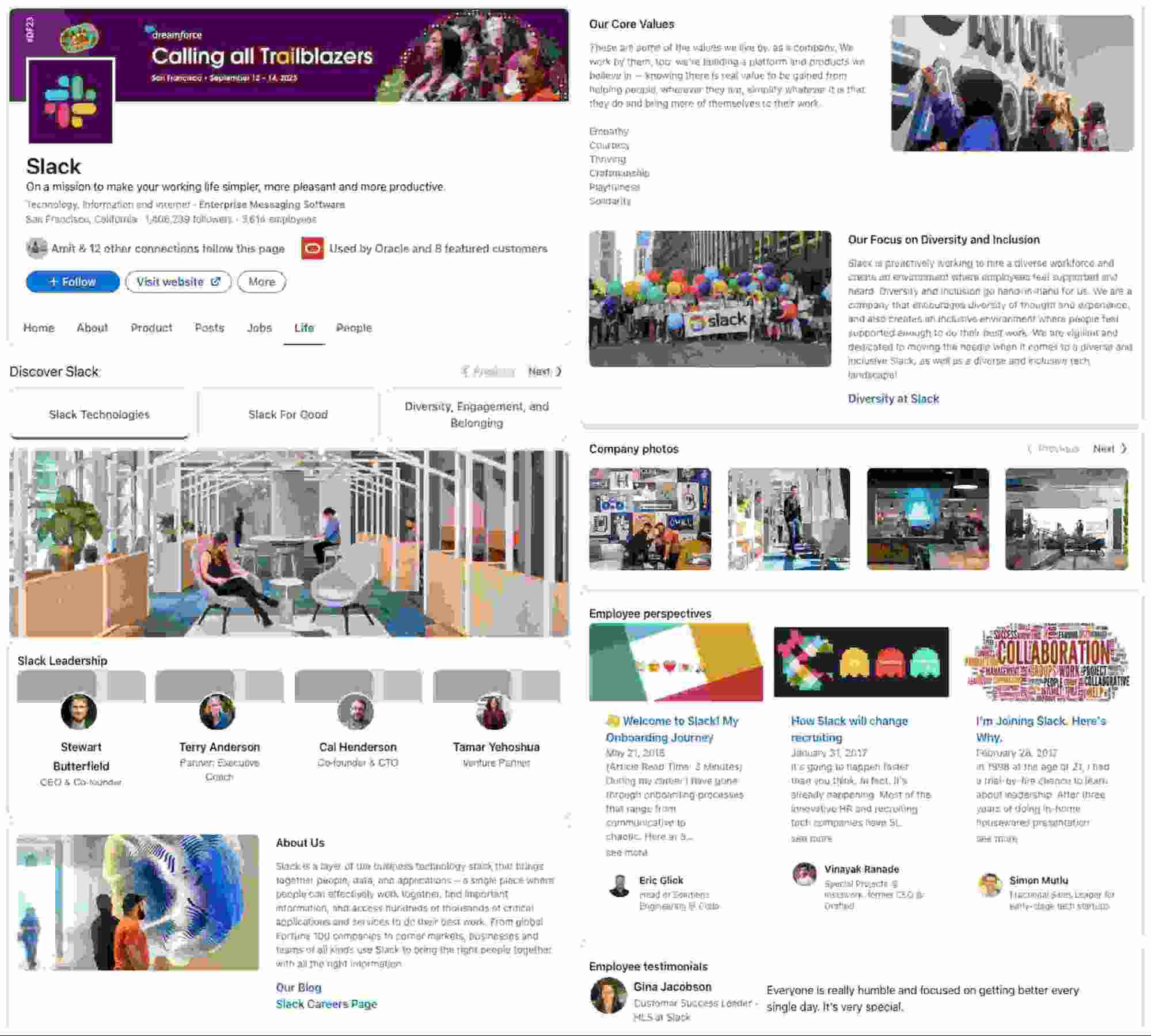Few stories resonate as powerfully as Slack’s meteoric rise to success. Within a mere 24 hours of its launch in 2013, it attracted 8,000 users. A fortnight later, this number had almost doubled. From being snapped up by Salesforce for an astounding $27.7 billion to acquiring 169,000 paid users, Slack’s growth trajectory to become the leading business communication tool is nothing short of legendary. But beyond these impressive numbers, beyond the beautiful instant messaging app they designed, lies their secret to success: Slack content marketing strategy.
Join us as we unwrap the secrets of Slack’s content marketing success, exploring the strategies that transformed this startup into a tech behemoth.
TL;DR Here’s a quick summary video of this case study
Role of content marketing at Slack
Slack Content Marketing Strategy
- The Slack blog
- Slack SEO strategy
- Leveraging email marketing
- Slack customer stories
- Slack social media strategy
- Experiments with podcasts
What we learned from Slack’s content marketing strategy

Slack: The Story of Growth
Chances are, you’ve already come across this name before, and perhaps you’re even using this tool. Slack is a team collaboration app designed for workplaces, with a wide range of features. It allows users to chat one-on-one, and also in groups, and can also be used across multiple platforms and devices.
Now, here’s an interesting fact: Stewart Butterfield, the man behind Slack, never planned to create an instant messaging app. He started with a gaming project way back in the early 2000s but hit a roadblock after the dot-com bubble burst. Even though he wasn’t able to raise any money for this project, his team had built an image-sharing app as part of this gaming venture. This went on to become Flickr, and it was eventually sold to Yahoo for $35 million.
Some years later, Butterfield tried to build another game called Glitch. This was again an unsuccessful attempt, and he knew he needed an alternate plan. An opportunity presented itself in the form of an instant messaging feature, that had already been developed for Glitch. Upon research, he found that there were not many instant messaging tools for professional teams in the market. So, this Glitch feature was turned into Slack and that is how this team chat app was born in 2013. It quickly gained traction and by 2015, it had over a million active users. Today, Slack has 200K+ paid customers, including 77 of the Fortune 100 companies.
And there you have it – the incredible story of how a failed game project led to the birth of the Slack app. It just goes to show that sometimes, the most incredible successes come from the most unexpected places. But, what’s the secret behind Slack’s explosive success? What did it do differently with its content marketing strategy to see this incredible growth in 10 years? We’ll be answering these questions in the upcoming sections.
Role of content marketing at Slack
Slack did not follow the traditional marketing playbook. They didn’t hire a Chief Marketing Officer (CMO) until they were already worth over a billion dollars, and they weren’t big on lead generation and SEO in the early days either. Their marketing recipe for growth was unconventional yet brilliant. Here are some strategies that they started with –
- Word-of-mouth marketing: Rather than relying on big marketing campaigns or flashy ads, Slack chose to let its users become its biggest advocates. Happy users spread the word, building Slack’s reputation as the ultimate tool to support collaboration.

Slack’s viral growth through word-of-mouth marketing (Source)
- Freemium model: Instead of offering their users a gated free trial that required customers to provide their credit card information, they focused on building trust. Slack could be used for free, which allowed teams to experience the product without any commitment. When users wanted more features like integrations or additional storage, they could upgrade. This freemium model was something we saw in our Canva content marketing case study too.
- Relentless iteration: Slack strived for excellence from the very beginning, never settling for anything less than the best. They continuously enhanced and optimized their product to ensure it exceeded all expectations.
- Integration innovation: Slack continuously added integrations to enhance the platform’s usefulness, resulting in improved user experience and increased referral traffic from partner apps.
- Listening to customers: Slack decided to focus on its customers from the very beginning. They paid attention to what their users wanted and needed, shaping their product based on real feedback.
When it comes to content marketing, Slack knows how to educate and engage its audience. They’ve understood the value of great content right from the start. Although word-of-mouth marketing will always play a big role in their growth, they’ve invested heavily in creating valuable content that educates their audience. In fact, the company spent more than 50% of its revenue on marketing and sales in 2019. They didn’t neglect SEO either, maintaining a high search visibility using content SEO best practices. They also built a strong presence on social media, sharing valuable content and engaging with their audience.
Slack Content Marketing Strategy
Slack’s content marketing strategy covers blogs, email newsletters, social media posts, case studies, and more. Let’s look at each element separately to see how it contributes to the overall strategy.
1. The Slack blog
We’ll begin by exploring how the blog articles on Slack blog help in educating users, nurturing leads, and attracting visitors to the website.

Slack blog
The Slack blog is cleverly named ‘Several people are typing‘, inspired by the familiar message that appears when teams chat on Slack workspace. This catchy name immediately catches people’s attention as soon as they land on the blog. Navigating the blog is also quite easy, with five distinct blog categories visible right on top. We observed this clever grouping of blog posts in some of our previous case studies on Airtable content marketing, Park+ content marketing strategy, and Chime content marketing strategy. Besides making it easier for visitors to quickly find content that interests them, proper categories and tags improve the search functionality of the blog too.
Looking at Slack’s blog content, it becomes clear that their focus is primarily on providing people with –
- Product updates and news
- Helpful guides
- Productivity and collaboration tips
This is a great way to strike a balance between providing value to users and showcasing the capabilities of the platform. It could help enhance user engagement and encourage brand advocacy and loyalty, while also driving organic traffic to the page. It’s a win-win approach that benefits both Slack and its user community.
Slack also leverages product-led marketing, seizing every opportunity to plug its features into the content. For instance, this article on tips for nurturing team culture explains how Slack tools can help in regular check-ins with your team.

Product-led marketing on Slack blog
Or, this blog post on the use of emojis in the workplace, where they explain how Slack emojis are baked into the workflow to simplify repetitive follow-ups –

Delivering value through Slack blog
In both these examples, it’s evident that they prioritize delivering valuable content to their audience without making it feel like a sales pitch.
Few other content marketing strategies can generate as much product awareness among your audience as effectively as product-led content. That’s probably why many SaaS companies are investing in this marketing strategy, as we had seen in our Monday content marketing case study, HubSpot case study, and the one on ClickUp’s content marketing strategy.
2. Slack SEO strategy

If you look at this data from Similarweb, the top sources of traffic for Slack are –
- Direct traffic (94.69%): This came from people typing “Slack” directly into their browsers, probably because the brand has become synonymous with team communication.
- Organic Search (3.15%): When people looked for team chat solutions, Slack was right up on top.
- Referrals (1.65%): The referral traffic comes from their strong brand presence and word-of-mouth marketing.
Even though the traffic generated through organic search is significantly less than direct traffic, it is still the second-biggest contributor. So, they must be doing something right with their SEO strategy. While other brands focus on content marketing to improve their SEO, Slack takes a different approach. Instead of targeting specific key phrases to direct their users to their blog, they focus on directing the visitors to their app directory landing pages. Take a look at some of Slack’s top organic keywords, which were compiled in a fascinating research article from OVBlog. Each of these keywords leads to one of Slack’s App Directory landing pages.

It’s quite clear that the people searching for these keywords are not specifically looking for Slack, but other tools like Zapier, Trello, or Google Drive. All these tools listed above have integration capabilities with Slack, and Slack has cleverly capitalized on this by creating individual landing pages for each integration. This strategy ensures that Slack frequently appears on the first page of search results when users search for a product that integrates with Slack.
Besides these keywords, Slack also ranks for many branded keywords, like ‘Slack app’, ‘Slack pricing’, and ‘Slack download’, which direct the searchers to different web pages. In addition to the branded keywords, Slack usually targets other important keywords that directly relate to their product, like messaging and team communication. Because of Slack’s impressive word-of-mouth brand marketing efforts, they don’t have to invest heavily in content SEO. Their brand name and product offerings speak for themselves.
3. Leveraging email marketing
With its keen grasp on user needs, Slack has built a brilliant email marketing strategy to both attract and retain its users. While many companies make the mistake of spamming their users with emails that often miss the mark, Slack takes a different approach. Their email marketing strategy reflects the essence of their product philosophy: efficient, direct, and user-focused communication.
When a user receives a marketing email from Slack, it’s like a continuation of their in-app experience. Here’s an example of an email newsletter from Slack, explaining its latest feature.

Newsletter from Slack
It’s clear that Slack prefers a concise yet impactful format over lengthy emails for its users. A crisp headline grabs the recipient’s attention, followed by concise copy that gets straight to the heart of the message. They also add multiple Call to Action (CTA). Concise and impactful emails allow users to understand the core message quickly and take immediate action, which results in higher engagement rates.
Another aspect of Slack’s email marketing strategy is the frequency of their email communication. For Slack, it’s all about delivering relevant and timely content. This is why they make a conscious choice to communicate when it adds value, rather than just to occupy mindshare.

4. Slack customer stories
Besides helpful guides and blog articles, Slack’s Resources Library has another page called ‘Customer Stories’. This is where they share their case studies, putting the spotlight on organizations that have successfully leveraged Slack to improve their workflows, communication, and overall productivity. Presenting customer stories as case studies is something we noticed with Marketo’s content marketing strategy as well.

Slack customer case studies
Slack has an impressive portfolio of clients, with some big names like Canva, OpenAI, Razorpay, BBC, Intuit, and more. Each case study carefully examines how these businesses have seamlessly integrated Slack into their operations. What’s unique about these case studies is the human element. Beyond highlighting the technical and operational improvements made with Slack, these case studies explore the personal stories behind the success. They highlight the challenges faced by teams, the collaborative efforts undertaken, and the individual journeys of employees as they adapt to Slack as a communication tool. Some case studies also include video testimonials. These customer stories are not only meant to inspire potential users but also provide valuable insights into the diverse ways Slack can be tailored to meet specific business needs and objectives.
This page also comes with a convenient option to filter case studies, based on industry, business size, region, and department. This makes it easier for visitors to quickly narrow down the case studies to those that closely match their own context and needs.

Case study filters on Slack website
5. Slack social media strategy
Slack has a strong presence and a huge following on all major social media platforms, including LinkedIn, Twitter, YouTube, and Instagram. Although each platform has its own unique focus, there are some shared elements in most of Slack’s social media posts –
- Consistent brand imagery, in the form of colors, font, and design
- Heavy focus on visuals with minimal use of text
- A variety of content, from short-form videos to beautifully designed graphics and images
Slack on LinkedIn
On LinkedIn, Slack boasts an impressive following of 1.4 million users. Since this is their channel for professional communication, they’ve adapted their tone to maintain a professional image. Most of the content here is sharing product updates and posts promoting their recent events. There are not many memes shared on this platform, but they do post occasional relatable captions like this one –

Slack LinkedIn post
What stands out about Slack’s LinkedIn social media marketing strategy is its ‘Life at Slack’ page. For jobseekers, it reinforces Slack as an attractive employer, while general visitors gain insight into the company’s team, values, and key initiatives. The page includes unique employee perspectives, company photos, and links to relevant pages to drive website traffic.

Slack on LinkedIn
Slack on Instagram
Slack’s presence on Instagram is also noteworthy, with more than 70K followers. Maybe not as big as LinkedIn, but still pretty good considering that it is a B2B SaaS company. The content on this platform is a mix of static images, reels, and carousels, but there’s a heavy focus on reels. And why wouldn’t it be? Instagram Reels have a reach rate of 20.59%, far more than any other type of content. The content variety also keeps their feed engaging and dynamic.
Another unique aspect of this channel is that Slack tries to make its posts both educational and fun for its users. Here’s an example of such a post, where they create a funny video clip to explain a Slack feature where you could add how your name should be pronounced.

Slack on Instagram
It is by building this kind of relatable content that Slack invites its audience to a conversation, which helps increase engagement on the platform.
Slack on YouTube
YouTube is where Slack focuses on providing informative and educational content. Visitors get a good view of everything on offer from the home page itself, with a well-categorized library of useful videos, consisting of –
- How to use Slack: Step-by-step guides
- Try this in Slack
- Understanding Slack
- Getting started in Slack
- Customer and Partner stories
- Security on Slack

Slack on YouTube
This categorization of videos makes it easier for users to locate specific information, whether they are looking for tutorials, advanced tips, or security-related insights. Since most of the videos are under 3 minutes, users can engage with content without feeling overwhelmed. Slack also hosts occasional live streams and posts some YouTube Shorts, diversifying the content mix.
Slack on Twitter
With a sizable follower count of nearly 500k and the coveted golden verified badge, Slack’s Twitter channel is an important contributor to its social media success. Slack actively uses polls on Twitter to understand their audience’s opinions and boost engagement.

Slack on Twitter
Slack strategically includes links to its website on Twitter to increase referral traffic, while also sharing blogs as tweets to further enhance direct traffic. This helps them most of their content on different platforms. Another unique aspect of Slack’s Twitter marketing strategy is the outstanding customer service they provide on the platform. They consistently engage with users, responding to inquiries and feedback promptly, even if it’s in other languages.

Slack customer support on multiple languages
6. Experiments with podcasts
As more and more people around the world are tuning into podcasts, it’s no surprise that podcast marketing has become a profitable strategy for businesses and brands. Slack started leveraging this content marketing strategy very early on. They initially ventured into the podcasting world by sponsoring podcasts with loyal audiences.
After a few years, Slack created its own podcasts. The first was “The Slack Variety Pack” podcast, which set itself apart from the competition by offering a one-of-a-kind voice and unique office stories.

Slack Podcast
When they wrapped up this podcast, they came out with another podcast, called “Work in Progress”, which followed a similar format.
The noteworthy aspect of Slack’s podcast strategy is its ability to promote the brand without resorting to a hard sell. They employ several clever techniques:
- Introductory mention: At the beginning of every episode, there’s a short announcement that the podcast is sponsored by Slack. It’s an invitation for listeners to visit Slack.com
- Non-salesy CTAs: In certain podcast episodes, Slack cleverly includes non-salesy CTAs that encourage listeners to participate.
- Listener engagement: At the end of each podcast, they urge listeners to join the conversation and share their thoughts and feedback using #SlackVarietyPack.
What we learned from Slack’s content marketing strategy
Whether it’s blog posts, webinars, or podcasts, Slack knows how to keep its audience hooked. Their content marketing strategy is a masterclass in providing value and staying consistent. Drawing insights from this content marketing strategy, here are actionable tips for businesses looking to emulate Slack’s success:
- Create product-led content: Leverage product-led content marketing to drive users down the funnel. When creating product-led content, strike a balance between showcasing your product’s features and providing genuine value, like tips, guides, and updates. Weave mentions of your product into your content without coming across as too pushy.
- Build SEO strategy for your web/landing pages: It’s a good idea to select keywords that will direct organic traffic to specific web pages and/or landing pages that offer unique value. These could be feature pages or any integration pages (if you offer integrations).
- Send emails with a purpose: Design your marketing emails to be concise, impactful, and user-focused. Avoid spamming subscribers and reach out only when you have something valuable to share.
- Invest in well-crafted case studies: Use case studies to demonstrate your product in action. Highlight both the technical benefits and the human stories behind the success.
- Maintain brand consistency across platforms: Keep a consistent brand voice and imagery across different platforms, adapting the tone to each platform’s audience. Narrato’s AI social media post generator could be a useful tool here, as it comes with built-in customization options to tailor your content to each platform’s requirements.
- Encourage two-way conversations: Actively invite your audience to participate in discussions, share feedback, and engage with your brand, whether it’s through comments, direct messages, or likes.
- Leverage podcasts to reach a new audience: If you have the time and resources, start a podcast on a theme related to your brand. Ensure your content offers genuine value and is not just a sales pitch.
- Experiment and innovate: Don’t be afraid to try new content formats or platforms. Whether it’s exploring newer social media trends or venturing into mediums like podcasts, be ready to adapt and evolve.
Win at SaaS content marketing with Narrato AI
Slack identified the power of content early on and flipped the script on traditional marketing strategies. Striking gold with its innovative word-of-mouth marketing approach, the brand continues to find new ways to reach out, resonate, and win over customers. So, if you’re looking to build your own content marketing strategy, take a page from Slack’s playbook. With Narrato AI to help you in your journey, there’s no stopping you from finding your own path to success. This powerful platform is packed with essential AI tools, like AI writer, AI Content Genie, AI content idea generator, AI SEO content brief generator, AI Chat Engine, and AI image generator. In addition to these features, the AI content workspace offers various tools for content collaboration, planning, and publishing, as well as team and project management.
Slack’s content marketing strategy has shown the way. Now, it’s your turn. Let Narrato AI be your strategic ally in building your brand story. Try it out today!





